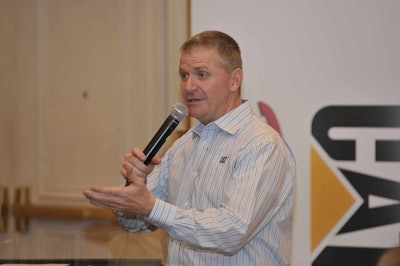

The driver of the no. 31 Caterpillar car gave a short talk, answered questions and posed for photos with the 12 finalists and their wives Friday night in Las Vegas. Accompanying Burton was Mike “The Bagman” Bagley.
When asked what it was like to drive the new Gen-6 cars on on the relatively short Las Vegas Motor Speedway, Burton was enthusiastic.
“We’ve had a lot of 2013 test sessions at 1.5-mile tracks. There are going to be a lot of questions at Las Vegas (Motor Speedway) for every team,” he said. “The new Gen-6 cars are really fast with a lot of grip … Add all that up and it means we are going to go really fast.”
He bragged on the new Goodyear tires and the downforce and power of the new cars while cautioning that what happens in testing and what happens in the race are two different things—the race being full of unknowns.
“It’s a high-speed chess game,” Burton said. “One thing you have to have in this race is speed. If you’re off by just 2/10 of a second that can take you from first to fifteenth.”
Burton was also asked if there was anybody he steered clear of on the track, anybody who was too aggressive. He acknowledged that Tony Stewart had that reputation in the past but that “there isn’t a driver that I look at on race day and cringe. In the past that hasn’t always been the case.”
A frequent question brought up by Contractor of the Year finalists is how he and other NASCAR drivers stay in shape for a race. Burton approaches his role like an athlete, working out at least three or four times a week. He’s also careful about his diet and mixes up his physical training regime to keep himself at the peak of his physical abilities. A lot of this has to do with being able to stay sharp for three or four hours inside a car that may be approaching 130 degrees.
Burton noted that some drivers take physical conditioning seriously and some don’t. Some lift weights, some just run, some do both and some do nothing.
When asked about his mental conditioning, how he handles the emotional pressure of a big race and how he unwinds when it’s over, Burton said he had learned in the last few years that you have to take a break. At the end of almost every race, he heads for home to spend time with his wife and kids and doesn’t even think about racing.
“In the past I was afraid that if I took a break, that there would be somebody else who was working harder than me,” he said. “I had to learn that it’s OK to go fishing. You have to prioritize your time. You can’t do it 24/7.”
And that’s good advice whether you’re pushing dirt or pushing 200 on the speedway.










